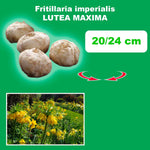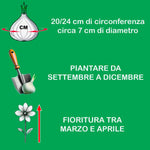-
Description
DESCRIPTION: Fritillaria imperialis in its ‘Rubra Maxima’ and ‘Lutea Maxima’ forms is one of the most fascinating bulbous plants. Fritillarias of the "imperialis" group have been cultivated in Europe since the late 1500s and were highly admired in the famous secret gardens of the seventeenth century. Surprisingly, these plants are still relatively little known today and are wrongly considered difficult to grow. It is particularly important to check the quality of the large bulbs when purchasing them (they are malodorous and for this reason were once considered a remedy against rodents): healthy bulbs, with firm, fleshy scales, will always give satisfactory results if planted early. The bulb should be planted at a depth at least twice its height, avoiding heavy watering immediately after planting to prevent water from collecting in the large central cavity left by the previous year’s stem. As soon as roots begin to develop (commercial bulbs often already have some roots formed in the peat or wood shavings in which they are stored), the plant starts producing protective substances that help prevent fungal attacks and rot. Leaving freshly purchased bulbs out of the soil for too long, which can lead to the drying out of early roots and outer scales, is the main reason for the occasional failures reported. During winter, rainfall provides all the moisture the plants need to survive. In spring, they will produce a stem bearing tufts of glossy green leaves. Plants grown in open ground can reach a height of 50–70 cm. The leaves are highly decorative, and beneath the tuft at the top of the stem is a circle of large, bell-shaped flowers (in the ‘Prolifera’ form, there are two rings of flowers). There are also variegated-leaf varieties (‘Argenteomarginata’ and ‘Aureomarginata’), and several cultivars have been selected for their unique flower colors (pale orange, deep orange, etc.). The flowers emit a faint but unpleasant smell, reminiscent of rotting meat. Good soil drainage is essential. This species is native to mountainous areas of Asia (from Turkey to Kashmir), where it grows in regions with snowy winters and dry summers. In the garden, even though it tolerates a wide range of soil types, these natural conditions should be mimicked by ensuring excellent drainage and leaving the bulbs undisturbed for several years. The plants thrive in full sun and should not be grown in soil that is overly rich in organic matter. Fertilization during the growing season should be done every three weeks with a balanced liquid fertilizer. As with all Liliaceae and spring-flowering bulbs in general, slug attacks should be monitored, but the biggest threat to young plants is the lily beetle (Lilioceris lilii), which is widespread in Italy. This pest takes advantage of the early emergence of Fritillaria (well before most Lilium) and damages the foliage. If bulbs are to be dug up at the end of the growing season, Fritillaria imperialis can also be planted quite late, even in semi-shaded woodland areas. The bright inflorescences add a mysterious touch to such environments.
PACKAGE: The package contains 1 bulb of Fritillaria imperialis 'LUTEA MAXIMA'; the bulbs have a circumference of 20/24 cm (approximately 7 cm in diameter). The packaging features a beautiful illustrative photo and includes planting and flowering information, making it an excellent gift idea.
HOW TO GROW: Plant the bulbs about 15/20 cm deep in full sun, either in pots or directly in the ground. Space each bulb approximately 15/20 cm apart. Be sure to use rich, well-drained soil, and water moderately. Bulbs should be planted between September and December. Flowering will occur between March and April.
SELECTION AND QUALITY: The bulbs come with a phytosanitary passport and undergo a strict quality control process to ensure splendid blooms from the first year.
AFTER-SALES ASSISTANCE: Customer satisfaction is our top priority. We are available to assist you with any questions or concerns regarding your purchase. You can contact us via the Amazon messaging platform or our dedicated WhatsApp line.















